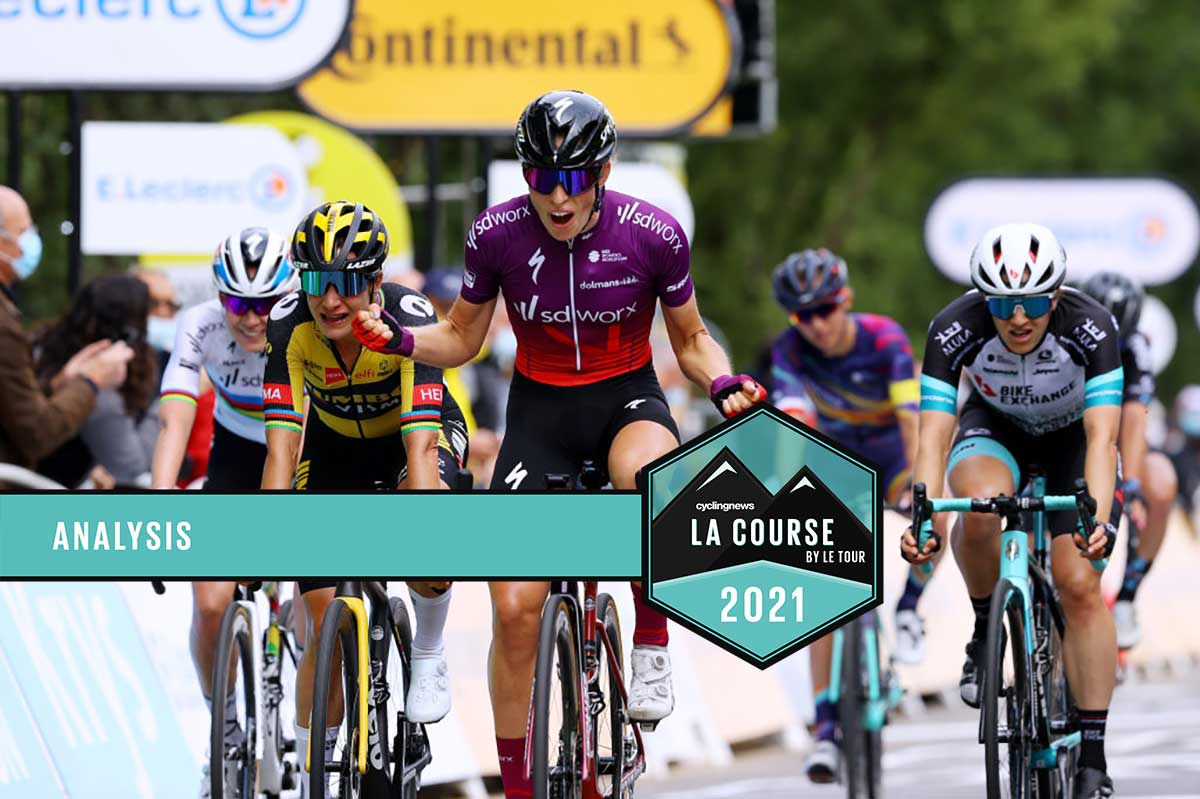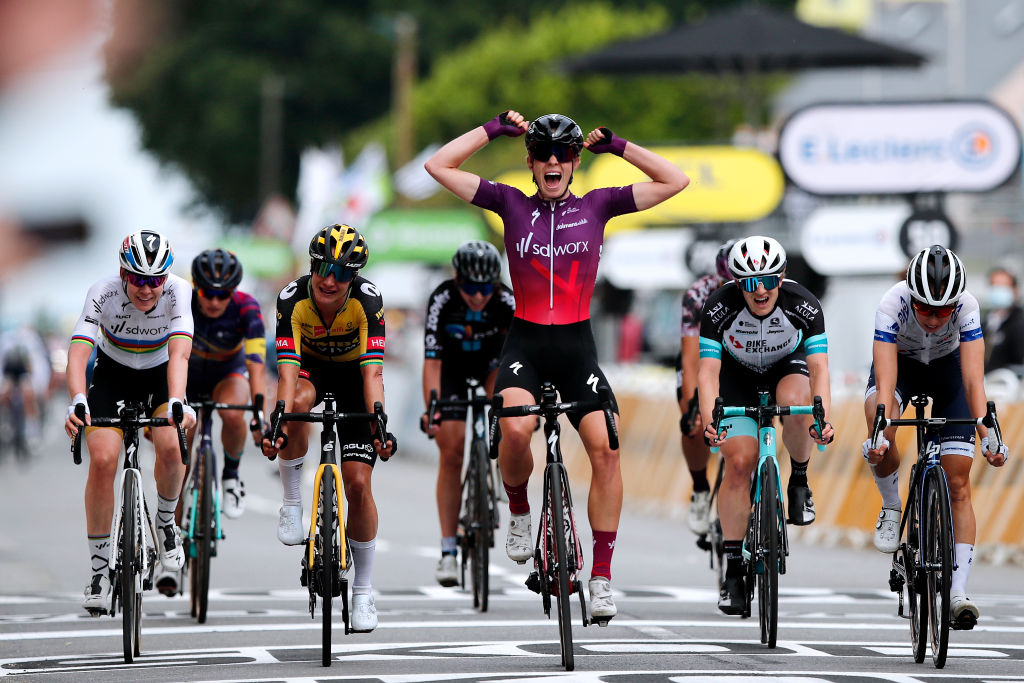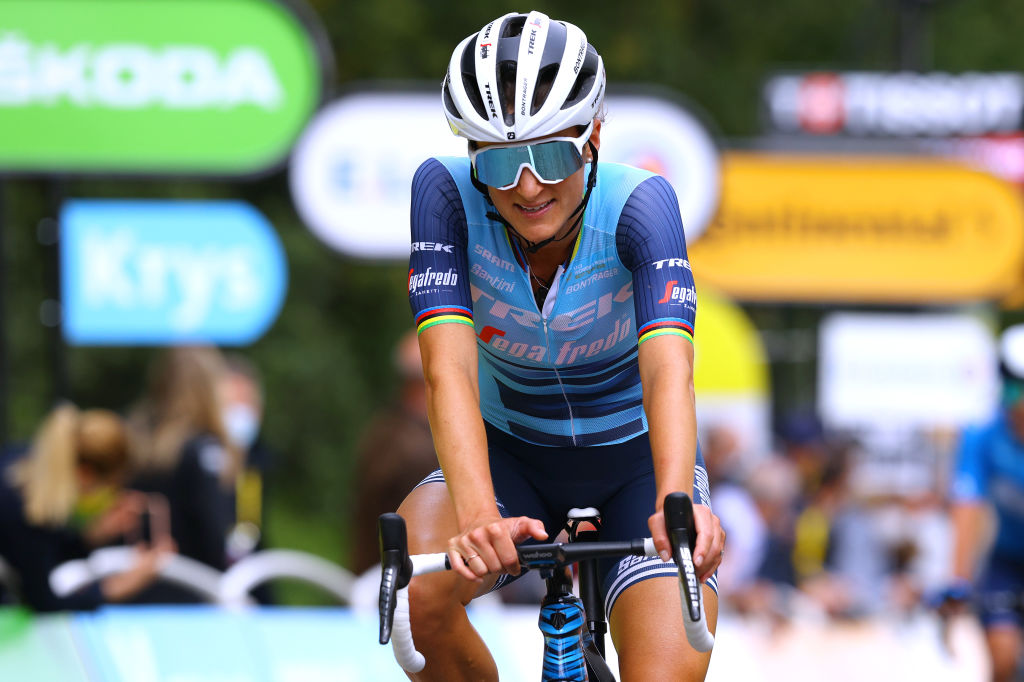5 conclusions from La Course by Le Tour de France
Vollering does it all while Uttrup Ludwig underlines form

It was an early start for the women’s peloton on Saturday for the eighth edition of La Course by le Tour de France. The race started at 8:20 a.m. European time but it was a symbol of the attitude that has haunted the race since day one. The women’s race hotels were located more than an hour from the start with the men populating the most conveniently-situated accommodation. Some painful 5 a.m. alarms later, and the women’s peloton converged in Brest for the next round of the Women’s World Tour.
Despite the annual decrying of La Course as a lacklustre nod to equality on the part of ASO, the racing itself is always far from lacking. Saturday was no different, and with wall-to-wall coverage, viewers were able to witness the non-stop attrition of women’s racing as continued attacks came and went even before the final fireworks started on the Côte de la Fosse aux Loups. In the end, it was the seemingly unstoppable juggernaut that is Demi Vollering (SD Worx) who outsprinted none other than Marianne Vos (Jumbo-Visma) to take the victory in Landerneau.
Ahead of the Giro d’Italia Donne starting on the July 2 and the Olympic Games coming later that same month, what did we learn from the race?
Fewer kilometres mean more action
An enduring observation around women’s cycling is that the racing is more dramatic and exciting, with one of the contributing factors being the typically shorter distances raced. La Course has been a case study in this over the past few years, particularly because most editions have had live coverage from start to finish meaning the early breaks and attacks are broadcast.
Last year’s instalment in Nice was under 100km but there was barely a moment to catch your breath during the entire race. At 107km, this year’s edition was one of the shortest Women’s World Tour races on the calendar but a shortage of kilometres does not equate to a shortage of action.
There was no such thing as waiting for the circuits and the climb before lighting the race up. The earlier stages of Saturday’s race were defined by the determination of French Continental squads Arkéa and Stade Rochelais Charente-Maritime to make it into a move. Cedrine Kerbaol of Arkéa eventually broke away solo but hers was one of many moves throughout the day in the continuous oscillation of the order of things.
The composition of the front groups was ever-changing with bigger teams putting riders up the road as well as Continental squads looking for their chances. The final ascent of the Côte de la Fosse aux Loups was nail-biting but the rest of the race wasn’t short on action.
Get The Leadout Newsletter
The latest race content, interviews, features, reviews and expert buying guides, direct to your inbox!
Regardless of distance, women’s races are almost always exciting throughout but it’s the short and explosive nature of races like La Course that provide the most compelling case for keeping it short but sweet.

Demi Vollering can do it all
It would have been a fitting piece of symmetry for Marianne Vos, who was part of the movement to bring the race about in 2014, to take the win at what might be the last ever La Course. It wasn’t to be for the Jumbo-Visma leader, however. For the second year in a row the woman widely credited as greatest cyclist of all time was outsprinted at La Course and at the mercy of a two-up tactic. This year, it was the SD Worx duo of Anna van der Breggen and Demi Vollering — rather than Lizzie Deignan and Elisa Longo Borghini of Trek — and with the unflappable World Champion acting as her super domestique, Vollering finished the job with precision.
“It almost went wrong because Vos was going all the way to the right and I was boxed in a bit. Anna made the speed and forced Marianne to go already. Then I could go in Marianne’s slipstream and come over her,” Vollering said after the race.
With Jumbo-Visma, a team that are still finding their feet, against the best team in the bunch Vos was at a disadvantage against Vollering and co, having to lead the sprint out. She’s been there before, however, and won but her climbing legs let her down on the Cote de la Fosse aux Loups.
The result in Landerneau leaves the Dutch Olympic squad’s tactics in question. On paper, Vollering is the young pretender who by rights should be put to work for three of the best and most experienced riders in the peloton. However, her recent achievements and all-rounder capabilities mean that Vollering could be The Netherlands’ best chance at a gold medal in Tokyo.
Cecilie Uttrup Ludwig is on fire
Her charm and exuberance make her one of the most compelling personalities in the peloton, despite being a consistent rider, however, Cecilie Uttrup Ludwig’s media profile had, until recently, somewhat belied her palmares. That was, until the Danish rider won her first Women’s World Tour race this season on stage three of the Vuelta a Burgos Feminas.
The confidence from that result was evident in the way the 25-year-old raced yesterday when she took the fight to the best in the world on the final ascent to the finish. Finding herself stuck in a group with some fast-finishers, she threw down one final attack that looked pretty dangerous until Anna van der Breggen decided to close it down in her usual effortless style.
Nevertheless, Uttrup Ludwig kept her cool and her position in the group of favourites, eventually overtaking Marianne Vos in the final sprint to take second behind Demi Vollering. With an impressive show of form like that, the FDJ Nouvelle Aquitaine-Futuroscope rider looks set to take a big result at next week’s Giro d’Italia Donne and even the Olympic Games.

Canyon-SRAM and Trek-Segafredo had the tactics but not the finish
Both Canyon-SRAM and Trek-Segafredo executed some of the most race-shaping tactics at La Course, however the sheer difficulty of the climb rendered their respective leaders, Kasia Niewiadoma and Lizzie Deignan, unable to finish the job.
Trek-Segafredo are known to play their cards right and it was in this very race last year that Elisa Longo-Borghini and Deignan outfoxed Marianne Vos. Lucinda Brand and Ruth Winder made themselves particularly useful this time, getting into moves and shutting down anything too dangerous, but Deignan admitted after the race that the edge just wasn't there: “To be honest today was just a bad day from the start to the finish. I felt terrible. So I knew it was just about suffering and I just didn’t have it when I needed it. I didn’t have the finish like the girls in front,” she said in a post-race interview.
Canyon-SRAM’s usual suspects of Mikayla Harvey, Elise Chabbey, and Omer Shapira animated the race for Niewiadoma early on while Tiffany Cromwell put in an almighty attack at the bottom of the final climb to set up her teammate. As things got serious towards the top of the Fosse aux Loups Niewiadoma was well-placed within the front group but her best chance would have been a solo move against fast finishers like Vos and Vollering. Stuck in the select group, the Polish rider finished 6th out of the 8 riders.
It’s no huge blow to either team, however, with mitigating factors including Deignan still returning to form after a tough spring fraught with illness, and Niewiadoma fresh from altitude. There’s a week for both riders to regroup before the Giro d’Italia Donne with it’s ten stages providing ample opportunity for the same tactics to prevail.
This was the last edition... or was it?
It’s widely believed that yesterday’s race was the last edition of La Course. ASO have not yet confirmed that they will be axing the one-day race in favour of the new Tour de France Femmes, however the La Course has not been added to the 2022 UCI calendar. With the eight-day race starting on the last day of the men’s Tour it looks unlikely that we will see La Course make a comeback.
A women’s race under the Tour de France banner has the potential to create untold opportunities for women’s cycling. The Tour brand transcends the sport of cycling and, regardless of the perceived pitfalls of the women following in the wheels of the men’s side of the sport, it is guaranteed to raise the profile of women’s racing.
Many of the riders themselves expressed their delight at being able to finally answer in the affirmative when asked if they will race the Tour de France. Marianne Vos, one of the four women who were instrumental in bringing about La Course and will surely have hoped for this moment to come sooner said, “it’s very nice that the Tour de France for women is coming back to the calendar as a full-fledged stage race. With opportunities for different specialists and all the elements that make cycling so beautiful. So boys and girls can dream of the yellow jersey.”
Whether this spells the end for La Course or not, it will be a new beginning for women’s racing.